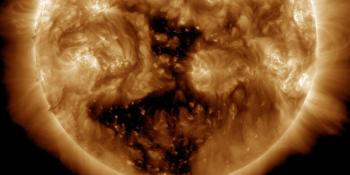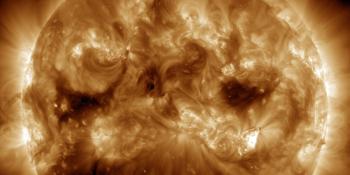Viewing archive of Saturday, 17 September 2011
Solar activity report
Any mentioned solar flare in this report has a scaling factor applied by the Space Weather Prediction Center (SWPC). Because of the SWPC scaling factor, solar flares are reported as 42% smaller than for the science quality data. The scaling factor has been removed from our archived solar flare data to reflect the true physical units.
Report of Solar-Geophysical Activity 2011 Sep 17 2200 UTCPrepared by the NOAA © SWPC and processed by SpaceWeatherLive.com
Joint USAF/NOAA Report of Solar and Geophysical Activity
SDF Number 260 Issued at 2200Z on 17 Sep 2011IA. Analysis of Solar Active Regions and Activity from 16-2100Z to 17-2100Z
Solar activity was low during the past 24 hours.
Regions 1289 (N22W67) and 1290 (S13W84) each produced C-class
events, the largest a long duration C2 event from Region 1289 at
16/2351Z. An associated CME first became visible on LASCO C2 imagery
at 16/2348Z and had an estimated plane-of-sky speed of 575 km/s.
Further analysis will be conducted to determine geoeffectiveness.
IB. Solar Activity Forecast
Solar activity is expected to be low
with a chance for isolated M-class flares for the next three days
(18-20 September).
IIA. Geophysical Activity Summary 16-2100Z to 17-2100Z
The geomagnetic field was quiet until approximately 17/0400Z when
effects from the 14 September CME arrived at Earth. A shock was
observed at ACE at 17/0256Z which was followed by a sudden impulse
of 21 nT observed by the Boulder magnetometer. Solar wind speeds
increased from approximately 350 km/s to 450 km/s along with a
noticeable increase in temperature and density. The interplanetary
magnetic field Bt reached +14 nT and there were several extended
periods of southward Bz with a maximum deviation of -12 nT.
Conditions at Earth increased to active levels following shock
arrival with an isolated minor storm period at 17/1800Z. Solar wind
speeds peaked at 550 km/s around 17/1115Z but have since decreased
to approximately 450 km/s. The greater than 2 MeV electron flux at
geosynchronous orbit reached high levels during the period.
IIB. Geophysical Activity Forecast
The geomagnetic field is
expected to be quiet to unsettled with a slight chance for isolated
active periods on day one (18 September) as effects from the 14
September CME subside. Mostly quiet conditions are expected for days
two and three (19-20 September).
III. Event Probabilities 18 Sep to 20 Sep
| Class M | 30% | 35% | 35% |
| Class X | 01% | 01% | 01% |
| Proton | 01% | 01% | 01% |
| PCAF | green | ||
IV. Penticton 10.7 cm Flux
Observed 17 Sep 145 Predicted 18 Sep-20 Sep 145/145/145 90 Day Mean 17 Sep 102
V. Geomagnetic A Indices
Observed Afr/Ap 16 Sep 002/002 Estimated Afr/Ap 17 Sep 023/032 Predicted Afr/Ap 18 Sep-20 Sep 010/010-005/005-005/005
VI. Geomagnetic Activity Probabilities 18 Sep to 20 Sep
| A. Middle Latitudes | |||
|---|---|---|---|
| Active | 20% | 10% | 05% |
| Minor storm | 10% | 01% | 01% |
| Major-severe storm | 01% | 01% | 01% |
| B. High Latitudes | |||
|---|---|---|---|
| Active | 25% | 15% | 05% |
| Minor storm | 15% | 05% | 01% |
| Major-severe storm | 01% | 01% | 01% |
All times in UTC
Current data suggests there is a slight possibility for aurora to appear at the following high latitude regions in the near future
Norilsk, VorkutaLatest news
Latest forum messages
Large Coronal Hole 25 153AR4043 20Aurora photography hints for those of us with smartphones 45Incoming & Unnumbered Active Regions 1644Photographing auroras 36
More topicsSupport SpaceWeatherLive.com!
A lot of people come to SpaceWeatherLive to follow the Sun's activity or if there is aurora to be seen, but with more traffic comes higher server costs. Consider a donation if you enjoy SpaceWeatherLive so we can keep the website online!

Latest alerts
16:15 UTC - Geomagnetic activity
Minor G1 geomagnetic storm (Kp5) Threshold Reached: 16:05 UTC
15:15 UTC - Geomagnetic activity
Minor G1 geomagnetic storm (Kp5) Threshold Reached: 14:59 UTC
09:15 UTC - Geomagnetic activity
Minor G1 geomagnetic storm (Kp5) Threshold Reached: 08:59 UTC
06:27 UTC - Hemispheric Power Index
The OVATION model predicts the Hemispheric Power Index to reach 54GW at 07:01 UTC
06:00 UTC - Geomagnetic activity
Minor G1 geomagnetic storm (Kp5) Threshold Reached: 05:51 UTC
Space weather facts
| Last X-flare | 2025/02/23 | X2.0 |
| Last M-flare | 2025/03/27 | M2.0 |
| Last geomagnetic storm | 2025/03/26 | Kp6+ (G2) |
| Spotless days | |
|---|---|
| Last spotless day | 2022/06/08 |
| Monthly mean Sunspot Number | |
|---|---|
| February 2025 | 154.6 +17.6 |
| March 2025 | 132.3 -22.3 |
| Last 30 days | 131.2 -21.8 |





